Have you ever tried an alphabet sensory bin with your preschoolers? This colorful sensory bin is perfect for teaching letter recognition and beginning sounds, as well as reinforcing these skills once they’ve been learned.
With a handful of simple materials, your preschoolers can immerse themselves in an all-encompassing sensory experience that makes learning the letters of the alphabet even more fun!
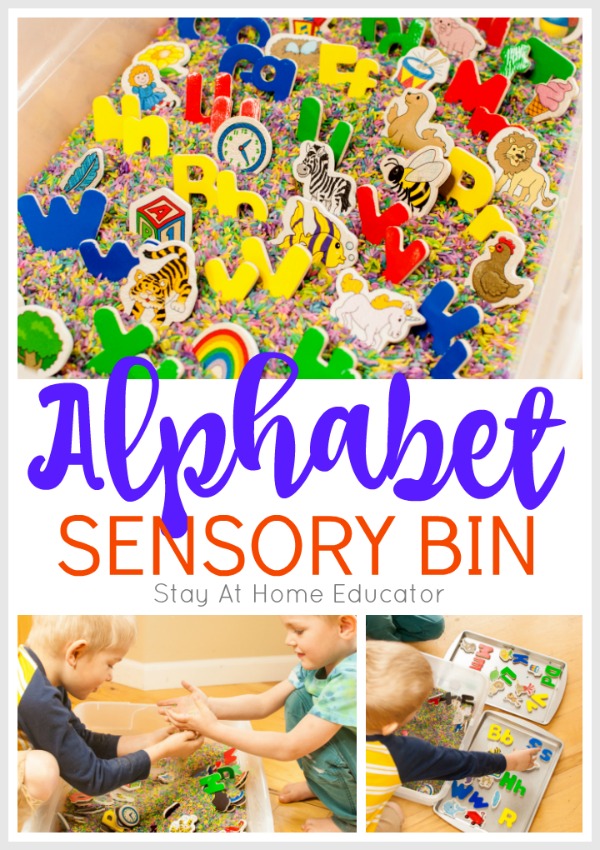
Alphabet sensory bins are making waves in the world of early childhood education, and for a good reason. These hands-on learning tools offer a fun and interactive way for children to familiarize themselves with letter recognition and beginning sounds, all while enhancing their sensory skills.
Sensory bins can be found in various forms online, each offering a unique tactile experience for children. (For example, we have an Easter sensory bin, and a construction themed sensory bin, and a colorful fall sensory bin just to name a few).
However, an alphabet sensory bin stands out for its educational value, combining the excitement of discovery with the foundational skill of letter recognition.
A sensory bin is not just a toy but a tool for active learning. They provide opportunities for children to actively use their senses, engaging their curiosity while promoting cognitive development.
This aligns perfectly with our alphabet sensory bin concept, where children can physically interact with letters, connecting their shapes and sounds in a tangible way.
You’ll also love this Valentine’s Day Sensory Bin with Beginning Sounds.
-
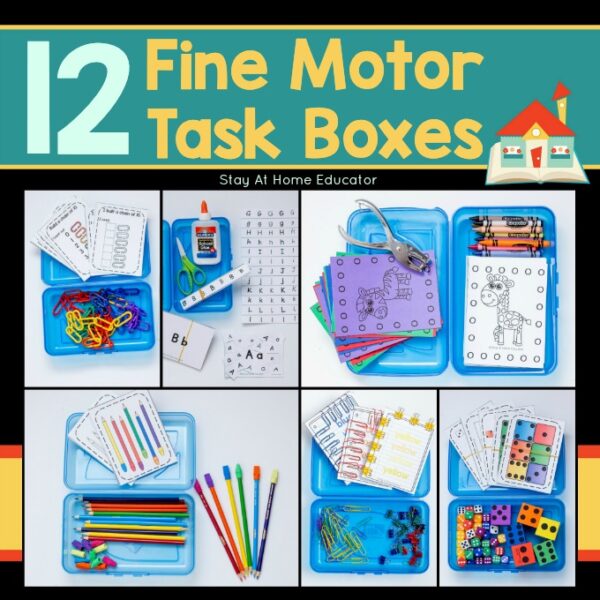 12 Fine Motor Task Boxes$10.00
12 Fine Motor Task Boxes$10.00
How to Make an Alphabet Sensory Bin
An alphabet sensory bin is a multi-faceted educational tool that offers a wealth of benefits. Here’s how to make one.
Materials
- rice
- magnetic letters
- trays that are magnetic, like from the Dollar store
- magnetic beginning sound pictures
The Set-Up
Begin by dying your rice. That will be the filler for our alphabet sensory bin. Happy Hooligans has a great recipe and how-to if you have not made it before.
Arrange the prepared rice as desired in a sensory bin. Then arrange the magnetic letters and beginning sound magnets.
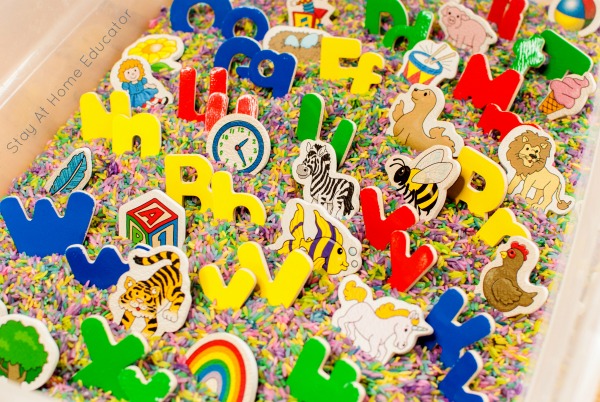
Unless your sensory bin is really big, you might not be able to fit everything in. I use an under-the-bed container, so I focused on the most recent letters and sounds we had been exploring in preschool instead of adding the entire alphabet.
Alphabet Sensory Activity
For this alphabet sensory bin, my boys were invited to play in the bin but also were challenged to match magnetic letters with magnetic pictures.
This call to action elevated the bin to more than just sensory play and exploration, but also gave me good insight as to how well they were learning their letters and sounds. All this being done in a fun, non-threatening manner.
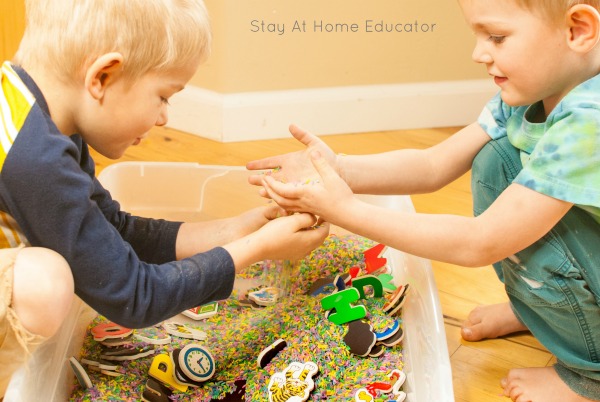
Their first reaction was to sift through all the colorful rice and drop it from their fingers. Dare I say I had to remind them a few times that “rice stays in the bin.” And then they began burying all the letters and playing “hide and seek” with them.
This is ok. They were naming the pictures and searching for specific letters as they played.
Eventually, I shook the bin of rice and we set up the letters and beginning sound pictures again. And then I set out the magnetic trays.
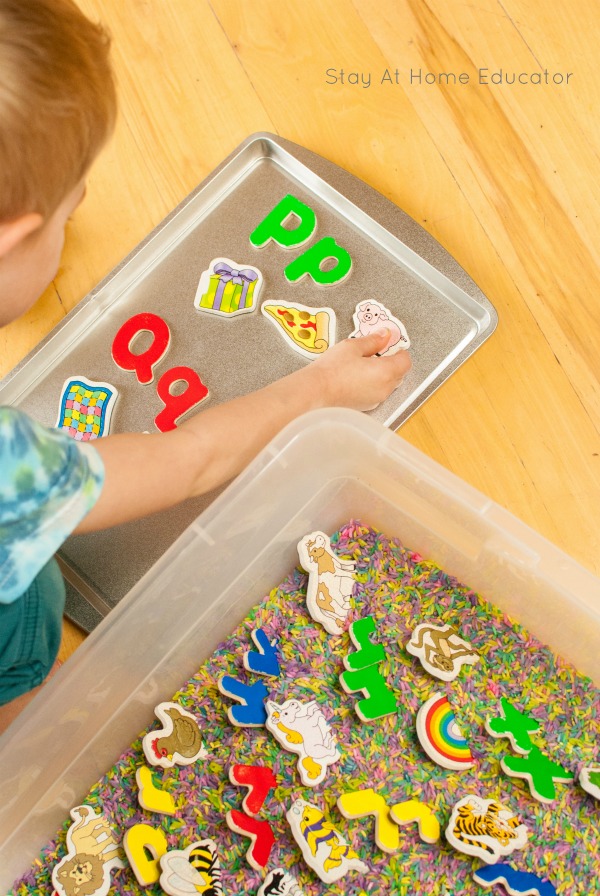
It was as though my boys already knew what do to. They naturally began to match up the letters with their corresponding pictures.
The fun here is in the magnets. Doesn’t every preschooler love to play with magnets? So using magnetic letters and pictures is naturally enticing and pairing it with literacy.
-
 12 Fine Motor Task Boxes$10.00
12 Fine Motor Task Boxes$10.00
We talk about this on our article: Sound Foundations: Enhancing Early Literacy Through Letter Sound Recognition.
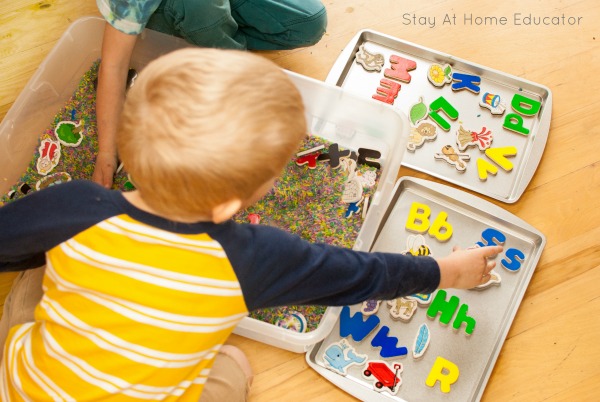
Soon, all the letters were matched with their beginning sounds. And the next thing I knew, my boys were putting everything back into the sensory bin and playing Hide and Seek again.
Alphabet Sensory Bin for a Range of Abilities
Sometimes it is difficult to know how to use sensory bins as a teaching tool. Let’s be honest…it looks like “just playing”. But here’s the catch…just playing is just learning!
Here are some ways to use a sensory bin to meet the needs of a range of abilities.
- Allow the children to choose how long they stay at the sensory bin.
- Keep it play-based. It’s important to not pressure the children into the “academic” side before they are ready. A sensory experience is still a learning experience. (One student, for example, might only bury the letters. But another student might voice that she is looking for said letter and then the first will un-bury it).
- Encourage the children to play and have fun. Maybe the letters fly and say their names or sounds as they fly to the magnetic trays.
- Use two sets of magnetic letters and invite preschoolers to find matching letters. Two uppercase letters, A A, or two lowercase letters, f f.
- Encourage the children to talk about the beginning sound magnets. Do they like to eat grapes? Where do you put a clock? When do you see stars? This will help develop their oral language skills.
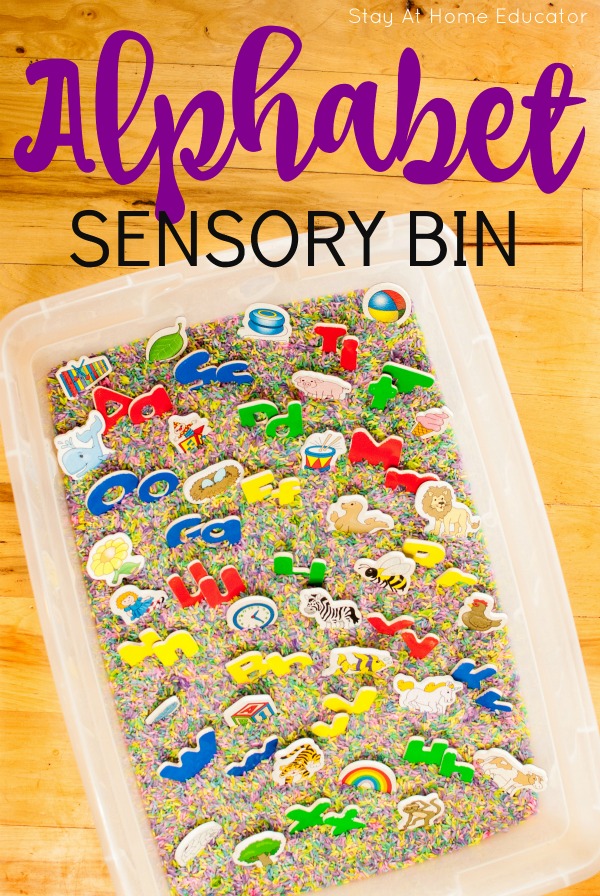
Alphabet Sensory Bin Ideas
Absolutely, here are some creative ideas for an alphabet sensory bin:
- Colored Rice Alphabet Bin: Fill the bin with dyed rice and hide magnetic alphabet letters in it. Children can search for the letters and match them to printed alphabet or letter formation cards.
- Sand and Seashell Alphabet Bin: Create a beach-themed bin with sand and seashells. Write different letters on each seashell for children to find and identify.
- Alphabet Pasta Bin: Use pasta shapes that resemble letters. Children can sift through the pasta to find and recognize different letters.
- Farm Theme Alphabet Bin: Fill a bin with farm animal toys and hay. Hide wooden alphabet letters among the animals for children to discover.
- Nature Alphabet Cards Sensory Bin: Use elements from nature like leaves, sticks, and stones. Write the alphabet on these items for a natural take on letter recognition.
- Beads and String Alphabet Bin: Fill the bin with beads that have letters on them. Provide strings so children can make their own alphabet necklaces.
- Alphabet Soup Bin: Create an ‘alphabet soup’ with water, food coloring, and foam letters. Children can scoop up letters using ladles or large spoons.
- Alphabet Ice Bin: Freeze small toys or colored water inside ice cubes, each with a different letter. As children melt the ice, they can identify the hidden letters.
- Construction Site Alphabet Bin: Fill a bin with sand, toy construction vehicles, and plastic or wooden letters. Children can ‘excavate’ the letters and match them to printed cards.
- Alphabet Garden Sensory Bin: Make a ‘garden’ with artificial grass, flowers, and insects. Hide letters among the flora for children to find and identify.
Remember, the goal of these bins is to provide a fun, hands-on way for children to learn letter recognition and beginning sounds. Enjoy creating your alphabet sensory bin!
-
 12 Fine Motor Task Boxes$10.00
12 Fine Motor Task Boxes$10.00
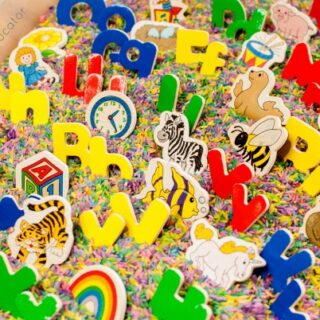
ALPHABET SENSORY BIN FOR LETTER RECOGNITION AND BEGINNING SOUNDS
Alphabet sensory bins are a wonderful way to combine sensory work with letter recognition.
These preschool sensory bins offer a fun and interactive way for children to practice with letter recognition and beginning sounds, while also developing their sensory skills.
The best part about an alphabet sensory bin? children get to physically explore letters, connecting their shapes and sounds in a tangible way.
Plus, preschoolers typically love sensory play, so they will likely get lots of alphabet practice that will merely feel like play!
Materials
- rice
- magnetic letters
- trays that are magnetic, like from the Dollar store
- magnetic beginning sound pictures
Instructions
- First, dye your rice. This is the filler for your sensory bin.
- Next, simply spread out the rice in your sensory bin and add your magnetic letters and beginning sounds magnets. Spread them out in whichever fashion makes sense for you and your preschoolers.
- Invite your preschoolers to play, while encouraging them to match magnetic letters with magnetic pictures.
- When you feel they have had ample time to explore, provide a magnetic tray for the children to place their letter/object pairs.
- Assist and guide the children, as needed. Encourage conversation about letter names, sounds, and what objects they can match. This is also excellent vocabulary building practice.
Notes
Modify your alphabet sensory bin to meet the needs of your preschoolers.
That might mean just including a few letters and matching objects, This could also mean setting more of a focus on uppercase/lowercase matching. You could also personalize it for individuals by only including the letters of their name (and corresponding objects).
There are many fun ways to make this activity meet the needs of your children.
Recommended Products
As an Amazon Associate and member of other affiliate programs, I earn from qualifying purchases.

I’m Sarah, an educator turned stay-at-home-mama of five! I’m the owner and creator of Stay At Home Educator, a website about intentional teaching and purposeful learning in the early childhood years. I’ve taught a range of levels, from preschool to college and a little bit of everything in between. Right now my focus is teaching my children and running a preschool from my home. Credentials include: Bachelors in Art, Masters in Curriculum and Instruction.

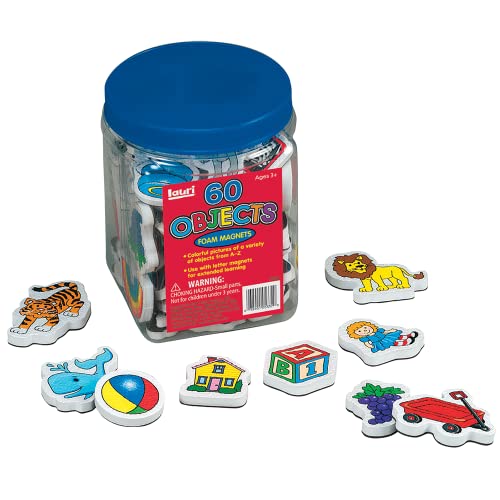


Where did you find he beginning sound magnets?
I just edited the post to give the link in the materials list.